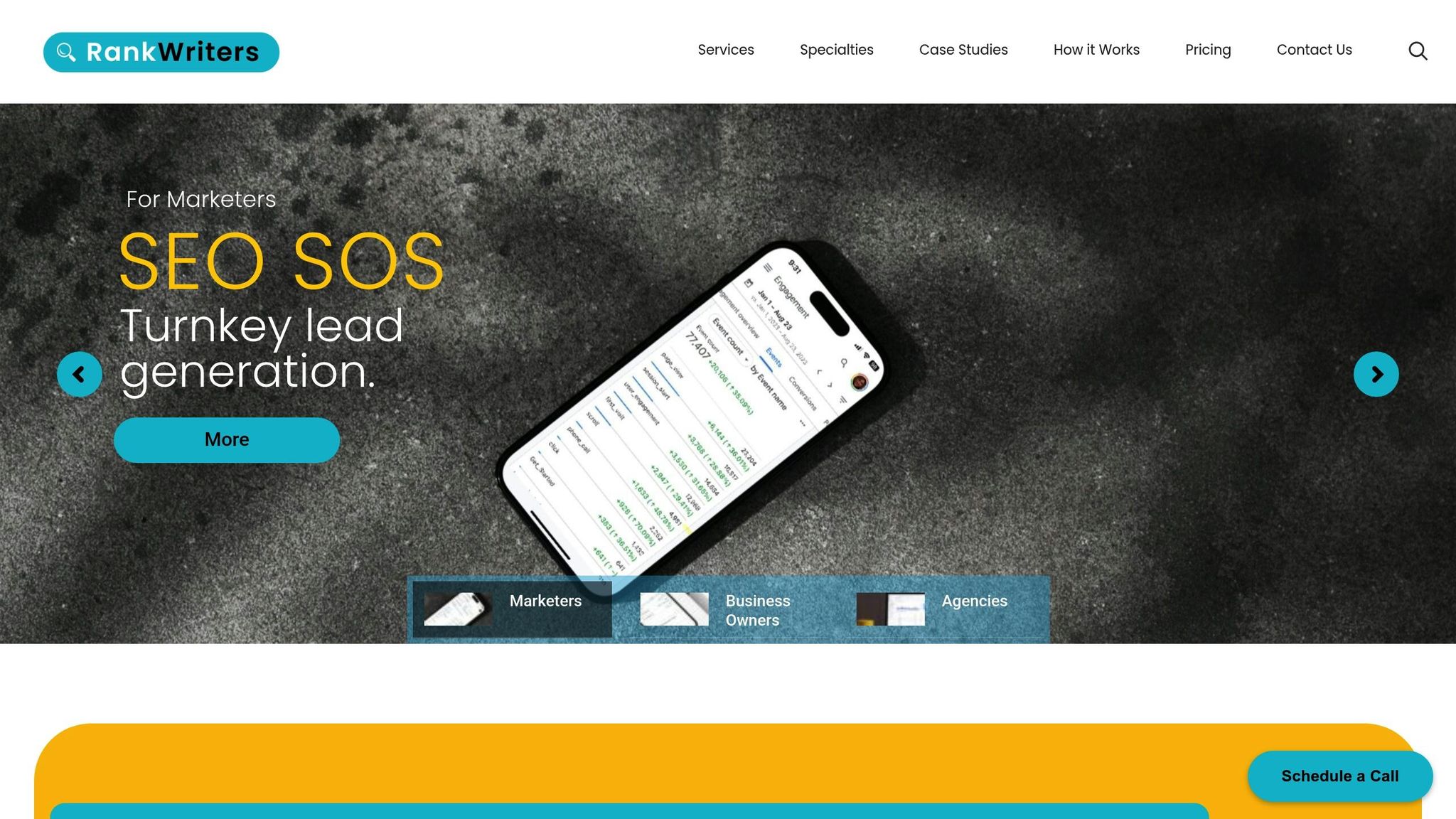Why it matters: The top 3 Google results get 75.1% of all clicks. If your law firm isn’t ranking high for key terms, you’re missing out on potential clients.
How to start:
- Identify competitors: Focus on firms in your area, offering similar services, and ranking for your target keywords.
- Use tools: Platforms like SEMrush, Ahrefs, and Google Keyword Planner help you discover competitor keywords, search volume, and ranking opportunities.
- Analyze keywords: Look for terms with clear client intent (e.g., “best divorce lawyer near me”) and manageable competition levels.
- Fill content gaps: Create content around keywords your competitors missed or underutilized.
- Track results: Monitor rankings, traffic, and conversions regularly to refine your strategy.
Quick tip: Don’t copy competitors – outperform them by creating better, more targeted content that aligns with your services and client needs.
How To Check Competitor Keywords (Using Ahrefs & Semrush)
Finding Your Main Competitors
Before diving into keyword research, it’s essential to figure out which law firms are competing for the same search traffic as you.
Mapping Your Market Competition
Start by listing law firms that compete with you in three main areas:
- Geographic Scope: Identify firms operating in your local area.
- Practice Areas: Focus on firms offering similar legal services. For instance, a family law practice shouldn’t analyze keywords from criminal defense attorneys, even if they’re nearby.
- Online Presence: Look for firms that:
- Appear in search results for your target keywords
- Actively create and publish content
- Maintain a blog
- Show up in local map pack results
Once you’ve mapped out your competitors, use specialized tools to confirm and expand your list.
Top Tools for Competitor Research
Here are some tools that can help you identify and analyze your online competitors:
| Tool | Primary Use | Key Features |
|---|---|---|
| Google Search Console | Identify direct competitors | Highlights which sites appear alongside yours for specific search queries |
| Google Maps | Analyze local competition | Displays top-ranked law firms in your area |
| SEMrush | Broader competitor analysis | Identifies websites targeting the same keywords |
| Ahrefs | Backlink and content gap analysis | Shows which sites rank for your target keywords |
When using these tools, focus on firms that consistently rank for terms related to your services. For instance, if you’re a divorce attorney, track firms ranking for phrases like "divorce lawyer [your city]" or "family law attorney near me."
It’s also important to separate market competitors (firms competing for clients in your area) from SEO competitors (websites ranking for your keywords). These groups can overlap, but not always. For example, a legal directory or law blog might rank for your keywords but isn’t competing for your clients.
With a clear competitor list and data from these tools, you’re ready to dig into keyword insights.
Getting Competitor Keyword Data
Once you’ve identified your main competitors, the next step is to analyze their keyword data. This helps you understand which search terms are driving traffic to their websites.
Tools to Analyze Competitor Keywords
Here are some tools that can help you gather keyword data:
| Tool | Purpose | Key Insights |
|---|---|---|
| SEMrush | Discover competitor keywords | Search volume, keyword difficulty, SERP features |
| Ahrefs | Identify content gaps | Ranking positions, traffic value, keyword trends |
| Google Keyword Planner | Verify search volume | Monthly searches, competition level, bid estimates |
Focus on keywords that align with your legal services and target audience.
Key Metrics to Evaluate Keywords
When analyzing keywords, pay attention to these metrics:
Search Volume: Check for keywords with steady monthly searches in your area. For legal terms, local search volume between 100-1,000 per month often works well.
Keyword Difficulty: This measures how tough it is to rank for a keyword. For law firms, aim for:
- Low difficulty (0-30): Great for newer websites.
- Medium difficulty (31-60): Suitable for firms with some SEO experience.
- High difficulty (61-100): Requires significant SEO effort and resources.
Position Tracking: Keep an eye on where competitors rank for specific keywords. If competitors rank in positions 4-10, it might be easier for you to compete and gain visibility.
Using these metrics, you can pinpoint the terms that potential clients are actively searching for.
Choosing Keywords That Attract Clients
Not all high-traffic keywords will lead to conversions. Focus on finding keywords that show clear intent from potential clients.
Examples of High-Intent Keywords:
- "[practice area] lawyer near me"
- "best [city] attorney"
- "[legal issue] consultation"
- "hire [practice area] attorney"
- "experienced"
- "top-rated"
- "affordable"
- "24/7"
Pay close attention to long-tail keywords that reflect specific legal needs. For instance, "workers compensation lawyer for back injury" is more likely to convert than a broad term like "workers comp attorney."
Checking Keyword Purpose
Types of Search Intent
Understanding your competitors’ keyword strategy starts with identifying the intent behind those keywords. In legal searches, intent typically falls into three main categories:
| Intent Type | Description | Example Keywords |
|---|---|---|
| Research Intent | Users looking for legal information | "what is workers comp worth", "statute of limitations personal injury" |
| Navigational Intent | Searching for specific law firms | "[firm name] reviews", "[attorney name] office location" |
| Commercial Intent | Ready to hire legal services | "hire divorce lawyer", "personal injury attorney free consultation" |
Once you understand the intent, align these keywords with the specific legal services you offer.
Matching Keywords to Services
To make the most of your keyword strategy, map them directly to your practice areas. Here’s how:
Service-Specific Mapping
Sort keywords into categories based on your core practice areas. For instance, if your firm handles personal injury cases, you might group keywords like this:
- Auto accidents
- Workplace injuries
- Medical malpractice
- Slip and fall cases
Intent Verification Process
Before finalizing the keywords you want to target, follow these steps:
- Check that top-ranking pages for those keywords align with your legal services.
- Confirm the keywords reflect your local presence and match what you offer.
- Exclude any terms that don’t fit your services.
This ensures you’re focusing on keywords that bring in relevant leads.
Content Pillar Integration
Organize your chosen keywords into content pillars that represent your main practice areas. This approach not only helps search engines understand your expertise but also provides a clear path for potential clients. For example:
- Personal Injury Pillar
- Car accidents
- Workplace injuries
- Premises liability
Each pillar should guide potential clients through the decision-making process, from research to hiring, so you can engage leads at every stage.
Building Your Keyword Plan
Leverage competitor keyword data to spot gaps and create a focused plan that taps into overlooked opportunities.
Finding Missed Keywords
To uncover untapped keywords, start with a detailed analysis of your competitors. Look at the keywords and topics they prioritize, then dive deeper into keyword research to find related terms or niche phrases they might have skipped. Pay attention to location-specific terms or specialized legal phrases they haven’t emphasized – these could be valuable opportunities for your firm to stand out.
Writing for Target Keywords
Create content that resonates with both search engines and potential clients. Seamlessly include target keywords in title tags, headers, and throughout the body text. Organizing your content around main topics – often called content pillars – helps search engines grasp the connections between topics while ensuring your pages meet client needs. For example, a personal injury page could cover various case types, offer local legal insights, and include clear calls to action.
After optimizing your content, keep an eye on its performance so you can fine-tune your strategy as needed.
Measuring Results
Track key metrics such as keyword rankings, organic traffic, form submissions, and phone calls. Since the top three Google results account for 75.1% of clicks [1], securing a high position is critical. Set up a regular review process – monitor keyword performance weekly for quick insights and assess broader trends monthly. Use this data to refine your approach, focusing on keywords that show the most growth potential and attract new clients.
Next Steps
Main Points Review
Identify your legal competitors, study their keyword strategies, and focus on targeting high-intent keywords. Since the majority of clicks go to the top three Google results, prioritize terms where you have a strong chance of ranking well. These steps build on the competitor keyword insights we’ve already covered.
Keep an eye on key metrics to measure progress:
| Metric Type | What to Monitor | Review Frequency |
|---|---|---|
| Rankings | Changes in keyword positions | Weekly |
| Traffic | Organic visits to important pages | Monthly |
| Engagement | Metrics like time on site and bounce rate | Monthly |
| Conversions | Actions like contact form submissions and calls | Weekly |
Use this data to fine-tune your approach over time.
RankWriters Services

Need expert help? Turn your website into a lead-generation powerhouse. At RankWriters, we specialize in creating SEO-driven content pillars using competitor research, targeted keyword analysis, and ongoing monitoring to deliver real, measurable results.







